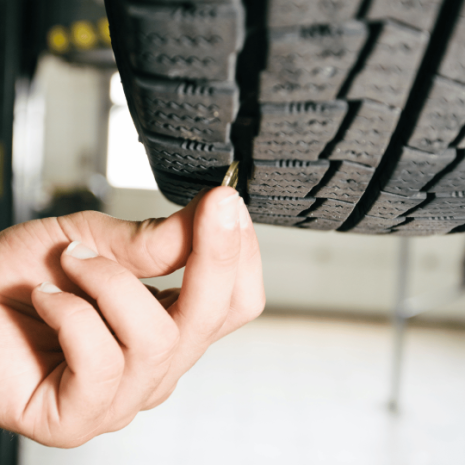To ensure a safe and smooth journey, it's important to perform several quick and easy vehicle checks. Here’s a detailed guide on what to check and why it matters.
Your tyres are the only part of the vehicle that is in contact with the road. It is extremely important that they are well always maintained and in good condition.
How to check your tyres’ tread depth
The legal tread depth limit is 1.6mm.
To measure the tread depth, insert a depth gauge into one of the central gaps along the circumference of the tyre.
If the tread is as shallow or shallower than 1.6mm you should replace the tyres as soon as possible.
Top Tip – a 20p coin’s rim is exactly 1.6mm. Use one to measure instead if you don’t have a depth gauge.
Driving on bald tyres could result in a fine from £2,500 up to £10,000.
How to check your tyres’ pressure
- This can be found on the inside of the door frame or the vehicle’s manual.
- Measure current tyre pressure by removing the valve cap. Press the pressure gauge onto the valve stem until the hissing stops and the gauge gives a reading.
- If tyres are over-inflated, press the metal pin inside the valve stem with a screwdriver or use the pressure gauge to release air until reaching the desired pressure.
- If tyres are under-inflated, use an air compressor to refill them.
- Attach the compressor hose to the valve stem and fill until the gauge shows the correct PSI.
- Digital compressors can be set to the desired pressure and will stop automatically when reached.
Driving with underinflated or overinflated tyres can negatively impact braking distance, steering, fuel efficiency, and tyre lifespan. Bulges, cracks, and splits in the rubber are a sign that your tyres’ need replacing as well, don’t ignore them if you spot one.
Top Tip – pocket your air valve dust caps when they’re not attached – they’re very small and easy to lose if left on the floor!
Motor oil is what keeps your engine running smoothly. It’s important that you regularly check how much you have in the tank. If you run out, your engine will seize up and you will break down.
How to check you have enough oil
- You can find your oil tank next to the engine, indicated with a yellow lamp icon.
- Remove the dipstick, wipe it clean with a rag or tissue then dip it back into the tank.
- When the stick is removed from the tank the second time, it will show a line to indicate the level of oil.
- Make sure this line is between the min and max markers on the dip stick.
- If the line is below the ‘min’ mark, use the larger port to top up the tank gradually, and repeat the dip test to check your new level.
Top Tip – for a more accurate reading, run the engine for 15 minutes before checking the oil level.
Maintaining the screen wash at the proper level ensures clear visibility by allowing you to clean debris or dirt off your windscreen.
How to refill your windscreen washer reservoir
- With the engine turned off, open the bonnet and locate the washer bottle, often identified by a blue cap with a windscreen symbol.
- If you have trouble finding it, consult your owner's manual.
- Remove the cap and fill the washer bottle with screen wash until it’s full. You can use either a pre-mixed solution or a concentrate diluted as per the instructions.
- Replace the cap securely, and you’re ready to go.
Functional lights are essential for your visibility and to communicate your driving actions to other road users.
How to check your vehicle’s lights
- It's much easier check your lights if you get somebody to help.
- Turn the ignition to first position. You may need the engine running for the lights to work.
- Check the light in this sequence: side lights, dipped beams, main beam, fog lights, front indicators, brake lights, reversing lights, rear indicators and hazard lights.
- If any of your lights aren't working properly make sure you have them replaced immediately.
Top Tip - If you don’t have someone who could help you check the lights. You can also park facing a wall at night and inspect the light they give off or use a reflective surface.
Always keep your fuel tank at least one-quarter full to avoid running out. Running out of fuel can result in a Fixed Penalty Notice in some locations.
Having a comfortable seating position is essential for safe driving. If you share a household vehicle, use a work pool car, or drive for a living then the chances are the seat position won’t stay the same each time you use it.
What to remember when adjusting your seat
Everybody’s way of sitting is different, make sure you’re comfortable and confident you’re fully in control of every aspect of the vehicle by:
- Testing the peddles.
- Relaxing your elbows with your hands at the 13:50 position on the steering wheel.
- Adjusting your mirrors.
- Wearing your seatbelt across your chest, not your neck.
Top Tip – There are loads of seat adjustments you can make, take the time to familiarise yourself with what each lever, knob, button, and dial does.
- Plan your route before leaving and identify places where you can take breaks if needed.
- Check weather conditions before setting off. If adverse weather is expected, consider delaying your journey.
Ensure you are well-rested and not under the influence of alcohol or drugs before driving. Check the latest traffic conditions using these pages:
Road traffic alerts | Traffic Wales

